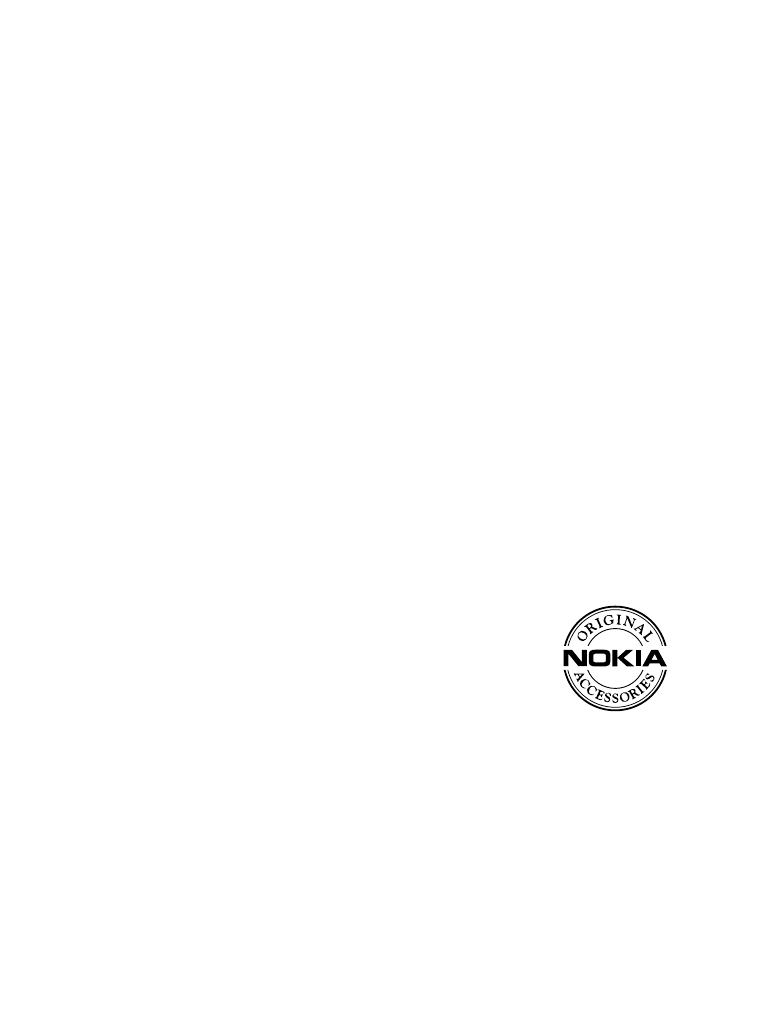
Reference information
•
USE ACCESSORIES SAFELY
This section provides information about the phone’s batteries, accessories, and chargers. Be
aware that the information in this section is subject to change as the batteries, chargers, and
accessories change.
This phone is intended for use when supplied with power from an ACP-7U, ACP-8U, ACP-12U,
or LCH-9 charger. Other usage could invalidate any approval given to this apparatus and may
be dangerous.
Warning!
When you purchase batteries, chargers, and accessories for your phone, use
only batteries, chargers, and accessories that have received approval from Nokia. The
use of any other type may invalidate any approval or warranty applying to the phone,
and could also be dangerous. For availability of approved batteries, chargers, and
accessories, check with your service provider.
Note:
For information on how to charge and recharge your battery, please see “Charge
the battery” on page 8.
When the battery is fully charged, the indicator will tell you that the battery is fully charged.
When you are not using a charger, disconnect it from the power source. Do not leave the
battery connected to a charger for more than 72 hours, since prolonged maintenance charging
could shorten its lifetime. If left unused, a fully-charged battery will discharge over time.
Temperature extremes can affect the ability of your battery to charge. Therefore, allow it to
cool down or warm up before trying to charge it.
When the battery is running out of power and your phone only has a few minutes of talk time
remaining, a warning tone sounds and the Battery low message appears briefly. When no more
talk time is left, a warning tone is sounded and the phone switches itself off.
Leaving the battery in hot or cold places, such as in a closed car in summer or winter conditions,
will reduce the capacity and lifetime of the battery. Always try to keep the battery between
59°F and 77°F (15°C and 25°C). A phone with a hot or cold battery may temporarily not work,
even when the battery is fully charged. Battery performance is particularly limited in temperatures
below freezing.
Do not dispose of batteries in a fire!
Warning!
Use only your hands to remove the battery. Do not puncture, burn or use
any objects that may damage the phone or the battery. Please recycle the battery, or
dispose of properly.
•
IMPORTANT SAFETY INFORMATION
This section provides additional safety information. A brief overview of safety can be found in
the section.
Traffic Safety
Do not use a handheld telephone while driving a vehicle. Always secure the phone in its holder;
do not place the phone on the passenger seat or where it can break loose in a collision or
sudden stop.
Remember road safety always comes first!

[ 71 ]
Reference information
Operating environment
Remember to follow any special regulations in force in any area and always switch off your
phone whenever it is forbidden to use it, or when it may cause interference or danger.
Use the phone only in its normal operating positions.
Electronic devices
Most modern electronic equipment is shielded from radio frequency (RF) signals. However, certain
electronic equipment may not be shielded against the RF signals from your wireless phone.
PACEMAKERS
Pacemaker manufacturers recommend that a minimum separation of at least 6 inches
(approximately 20 cm) be maintained between a handheld wireless phone and a pacemaker to
avoid potential interference with the pacemaker. These recommendations are consistent with
the independent research by and recommendations of Wireless Technology Research. Persons
with pacemakers:
• Should always keep the phone more than 6 inches (20 cm) from their pacemaker when the
phone is switched on
• Should not carry the phone in a breast pocket
• Should use the ear opposite the pacemaker to minimize the potential for interference.
• Switch off the phone immediately if you have any reason to suspect that interference is
taking place.
HEARING AIDS
Some digital wireless phones may interfere with some hearing aids. In the event of such
interference, you may want to consult your service provider.
Other medical devices
Operation of any radio transmitting equipment, including cellular phones, may interfere
with the functionality of inadequately protected medical devices. Consult a physician or the
manufacturer of the medical device to determine if they are adequately shielded from external
RF energy or if you have any questions. Switch off your phone in health care facilities when
any regulations posted in these areas instruct you to do so. Hospitals or health care facilities
may be using equipment that could be sensitive to external RF energy.
Vehicles
RF signals may affect improperly installed or inadequately shielded electronic systems in motor
vehicles (for example, electronic fuel injection systems, electronic antiskid/antilock braking
systems, electronic speed control systems, air bag systems). Check with the manufacturer or its
representative regarding your vehicle. You should also consult the manufacturer of any
equipment that has been added to your vehicle.
POSTED FACILITIES
Switch your phone off in any facility where posted notices so require.
Potentially explosive atmospheres
Switch off your phone when in any area with a potentially explosive atmosphere and obey all
signs and instructions. Sparks in such areas could cause an explosion or fire resulting in property
and/or bodily injury or even death.
Users are advised to switch off the phone when at a refuelling point (service station). Users are
reminded of the need to observe restrictions on the use of radio equipment in fuel depots (fuel
storage and distribution areas), chemical plants, or where blasting operations are in progress.

[ 72 ]
Areas with a potentially explosive atmosphere are often but not always clearly marked. They
include below deck on boats; chemical transfer or storage facilities; vehicles using liquefied
petroleum gas (such as propane or butane); areas where the air contains chemicals or particles,
such as grain, dust, or metal powders; and any other area where you would normally be advised
to turn off your vehicle engine.
Vehicles
Only qualified personnel should service the phone or install the phone in a vehicle. Faulty
installation or service may be dangerous and may invalidate any warranty which may apply
to the unit.
Check regularly that all wireless phone equipment in your vehicle is mounted and operating
properly.
Do not store or carry flammable liquids, gases or explosive materials in the same compartment
as the phone, its parts or accessories.
For vehicles equipped with an air bag, remember that an air bag inflates with great force.
Do not place objects, including both installed or portable wireless equipment in the area over
the air bag or in the air bag deployment area. If in-vehicle wireless equipment is improperly
installed and the air bag inflates, serious injury could result.
FCC regulations prohibit using your phone while in the air. Switch off your phone before
boarding an aircraft. The use of wireless telephones in an aircraft may be dangerous to the
operation of the aircraft, disrupt the wireless telephone network, and may be illegal.
Failure to observe these instructions may lead to suspension or denial of telephone services to
the offender, legal action or both.
Emergency calls
Important:
This phone, like any wireless phone, operates using radio signals, wireless,
and landline networks as well as user-programmed functions. Because of this, connections
in all conditions cannot be guaranteed. Therefore you should never rely solely upon any
wireless phone for essential communications (for example, medical emergencies).
Emergency calls may not be possible on all wireless phone networks or when certain network
services and/or phone features are in use. Check with local service providers.
Make an Emergency Call
1
If the phone is not on, switch it on.
2
Press the end key as many times as needed (for example, to exit a call, to exit a menu, etc.)
to clear the display and ready the phone for calls.
3
Enter the emergency number for your present location (for example, 911 or any other official
emergency number—emergency numbers vary by location).
4
Press the talk key.
• If certain features are in use, you may first need to turn those features off before you can
make an emergency call. Consult this user guide and your local cellular service provider.
• When making an emergency call, remember to give all the necessary information as
accurately as possible. Remember that your wireless phone may be the only means of
communication at the scene of an accident - do not end the call until given permission
to do so.

[ 73 ]
Reference information
•
CERTIFICATION INFORMATION (SAR)
THIS MODEL PHONE MEETS THE GOVERNMENT'S REQUIREMENTS FOR EXPOSURE TO
RADIO WAVES.
Your wireless phone is a radio transmitter and receiver. It is designed and manufactured not to
exceed the emission limits for exposure to radio frequency (RF) energy set by the Federal
Communications Commission of the U.S. Government. These limits are part of comprehensive
guidelines and establish permitted levels of RF energy for the general population. The guidelines
are based on standards that were developed by independent scientific organizations through
periodic and thorough evaluation of scientific studies. The standards include a substantial
safety margin designed to assure the safety of all persons, regardless of age and health.
The exposure standard for wireless mobile phones employs a unit of measurement known as
the Specific Absorption Rate, or SAR. The SAR limit set by the FCC is 1.6W/kg.* Tests for SAR
are conducted using standard operating positions accepted by the FCC with the phone
transmitting at its highest certified power level in all tested frequency bands. Although the SAR
is determined at the highest certified power level, the actual SAR level of the phone while
operating can be well below the maximum value. This is because the phone is designed to
operate at multiple power levels so as to use only the power required to reach the network. In
general, the closer you are to a wireless base station antenna, the lower the power output.
Before a phone model is available for sale to the public, it must be tested and certified to the
FCC that it does not exceed the limit established by the government-adopted requirement for
safe exposure. The tests are performed in positions and locations (for example, at the ear and
worn on the body) as required by the FCC for each model. The highest SAR value for this model
phone as reported to the FCC when tested for use at the ear is 1.28 W/kg and when worn on
the body, as described in this user guide, is 1.28 W/kg. (Body-worn measurements differ among
phone models, depending upon available accessories and FCC requirements).
While there may be differences between the SAR levels of various phones and at various
positions, they all meet the government requirement.
The FCC has granted an Equipment Authorization for this model phone with all reported SAR
levels evaluated as in compliance with the FCC RF exposure guidelines. SAR information on this
model phone is on file with the FCC and can be found under the Display Grant section of
http://www.fcc.gov/oet/fccid after searching on FCC ID GMLNPD-1AW.
For body worn operation, this phone has been tested and meets the FCC RF exposure guidelines
for use with an accessory that contains no metal and that positions the handset a minimum of
5/8 inch (1.5 cm) from the body. Use of other accessories may not ensure compliance with FCC
RF exposure guidelines. If you do not use a body worn accessory, and are not holding the phone
at the ear, position the handset a minimum of 5/8 inch (1.5 cm) from your body when the phone
is switched on.
*In the United States and Canada, the SAR limit for mobile phones used by the public is 1.6 watts/
kilogram (W/kg) averaged over one gram of tissue. The standard incorporates a substantial
margin of safety to give additional protection for the public and to account for any variations
in measurements. SAR values may vary depending on national reporting requirements and the
network band. For SAR information in other regions please look under product information at:
http://www.nokia.com
.

[ 74 ]